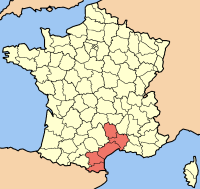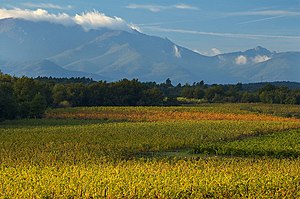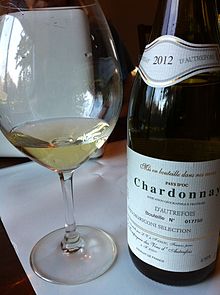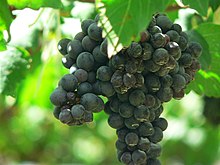
Viognier is a white wine grape variety. It is the only permitted grape for the French wine Condrieu in the Rhône Valley. Outside of the Rhône, Viognier can be found in regions of North and South America as well as Australia, New Zealand, the Cape Winelands in South Africa, south Moravia region in Czechia, Israel and in Austria at Weingut Roland Minkowitsch. In some wine regions, the variety is co-fermented with the red wine grape Syrah where it can contribute to the color and aroma of the wine.

Grenache or Garnacha is one of the most widely planted red wine grape varieties in the world. It ripens late, so it needs hot, dry conditions such as those found in Spain, where the grape is believed originated. It is also grown in the Italian island of Sardinia, the south of France, Australia, and California's Monterey AVA, Paso Robles, and San Joaquin Valley.

The Rhône wine region in Southern France is situated in the Rhône valley and produces numerous wines under various Appellation d'origine contrôlée (AOC) designations. The region's major appellation in production volume is Côtes du Rhône AOC.

Banyuls is a French appellation d'origine contrôlée (AOC) for a fortified apéritif or dessert wine made from old vines cultivated in terraces on the slopes of the Catalan Pyrenees in the Roussillon county of France, bordering, to the south, the Empordà wine region in Catalonia in Spain.

Collioure is an Appellation d'Origine Contrôlée (AOC) for French wines situated around the town of Collioure in the Roussillon wine region of France. Red, rosé and a few white wines are produced-the reds from Grenache noir, Mourvèdre, Syrah, Carignan and Cinsaut grapes; the white are made from a blend of Grenache blanc and Grenache gris. The boundaries of the AOC are identical with the Banyuls AOC as many of the grapes grown in Collioure are destined for use in the fortified Vins doux naturels of the region. The grapes that do not get used for Banyuls are then produced as non-fortified still wines under the Collioure AOC.
Côtes du Roussillon is an Appellation d'Origine Contrôlée for wines made in the Roussillon wine region of France. It is the least selective AOC in the Roussillon region. In 2002, 21,048,500 litres of Côtes du Roussillon were produced, 68% red, 28% rosé and 4% white. Grenache is the dominant variety in Red and Rosé. According to the AOC rules, however, red wines must be made with at least three varieties of grapes. The total of the two main variety grapes should not make more than 90% of the blend, and there must not be more than 60% of Carignan in it.
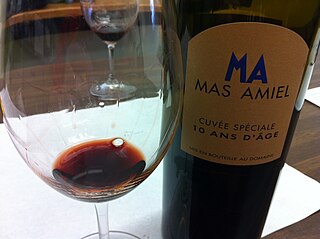
Maury is an Appellation d'Origine Contrôlée (AOC) for fortified vin doux naturel wines made in the Roussillon wine region of France. Almost all wines are red, made from at least 75% Grenache noir (Garnacha). Other permitted grapes are Grenache blanc, Grenache gris, Macabeu (Macabeo), Malvoisie du Roussillon (Tourbat), Syrah, Muscat and other local varieties. Although the grapes are different, they are used and marketed very much like port. It is made in the communes of Maury, Saint-Paul-de-Fenouillet, Lesquerde, Tautavel and Rasiguères. The AOC was granted in 1936.
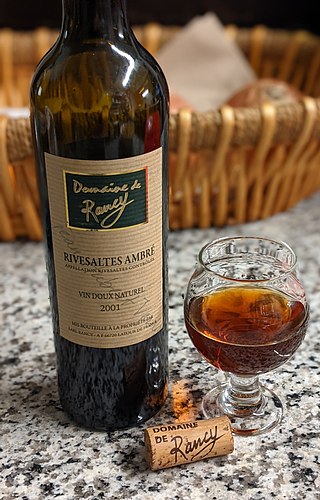
Rivesaltes is an appellation d'origine contrôlée (AOC) for naturally sweet, fortified wines. The name refers to both a production region within Languedoc-Roussillon in southern France, and the style of sweet wines produced there.

Châteauneuf-du-Pape is a French wine, an Appellation d'origine contrôlée (AOC) located around the village of Châteauneuf-du-Pape in the Rhône wine region in southeastern France. It is one of the most renowned appellations of the southern part in the Rhône Valley, and its vineyards are located around Châteauneuf-du-Pape and in neighboring villages, Bédarrides, Courthézon and Sorgues, between Avignon and Orange. They cover slightly more than 3,200 hectares or 7,900 acres (32 km2) and produce over 110,000 hectolitres of wine a year, more wine made in this one area of the southern Rhône than in all of the northern Rhône.
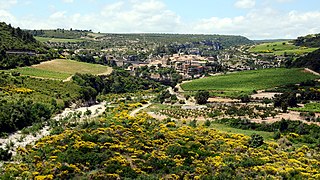
Minervois is an AOC in the Languedoc-Roussillon wine region, in the departments of the Aude and of the Herault. Historically, the region's capital has been the village of Minerve.

Fitou is a large French wine appellation in Languedoc-Roussillon, France. The dominant vine variety is Carignan which has to constitute 40% of any blend for that to qualify for the appellation. Grenache, Lladoner Pelut, Mourvèdre and Syrah are often blended with it. Muscat de Rivesaltes AOC, a vin doux naturel, also comes from the region.

French wine is produced all throughout France, in quantities between 50 and 60 million hectolitres per year, or 7–8 billion bottles. France is one of the largest wine producers in the world, along with Italian, Spanish, and American wine-producing regions. French wine traces its history to the 6th century BCE, with many of France's regions dating their wine-making history to Roman times. The wines produced range from expensive wines sold internationally to modest wines usually only seen within France such as the Margnat wines of the post war period.
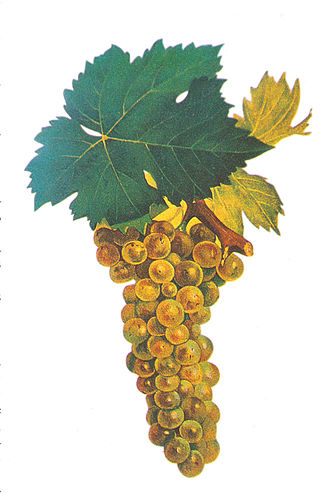
Muscat Blanc à Petits Grains is a white wine grape of Greek origin that is a member of the Muscat family of Vitis vinifera. Its name comes from its characteristic small berry size and tight clusters. It is known under a variety of local names such as Moscato bianco, Muscat blanc, Muscat Canelli, Muscat de Frontignan, Muscat de Lunel, Muscat d'Alsace, Muskateller, Moscatel de Grano Menudo, Moscatel rosé and Sárgamuskotály.

Cabardès is an Appellation d'Origine Contrôlée (AOC) for red and rosé wine in Languedoc-Roussillon wine region in France. Cabardès was named after the Lords of Cabaret who defended the Châteaux de Lastours against Simon de Montfort in 1209. Despite the name's medieval origins, this appellation is one of the youngest in France, having only become official in February 1999.
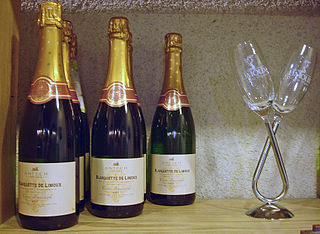
Limoux wine is produced around the city of Limoux in Languedoc in southwestern France. Limoux wine is produced under four Appellation d'origine contrôlée (AOC) designations: Blanquette de Limoux, Blanquette méthode ancestrale, Crémant de Limoux and Limoux, the first three of which are sparkling wines and dominate the production around Limoux. The main grape of the region is the Mauzac, locally known as Blanquette, followed by Chardonnay and Chenin blanc. In 2005, the Limoux AOC was created to include red wine production consisting of mostly Merlot. Wine historians believe that the world's first sparkling wine was produced in this region in 1531, by the monks at the abbey in Saint-Hilaire.

Corbières is an Appellation d'origine contrôlée (AOC) for wine in the Languedoc-Roussillon, France, and it is this region's largest AOC, responsible for 46 per cent of the region's AOC wine production in 2005. Red wine dominates the production in Corbières with almost 95 per cent, with 3.5 per cent rosé wine and 2 per cent white wine making up the balance. Carignan is the most common grape variety. The AOC was created in 1985, covers 13,500 hectares of vineyards and produces an average of 554,000 hectoliters of wine per year, corresponding to 74 million bottles.

Costières de Nîmes is an Appellation d'Origine Contrôlée (AOC) for wines that are produced in an area between the ancient city of Nîmes and the western Rhône delta, in the French department of the Gard. Formerly part of the Languedoc region of France, as the wines more resemble those of the Rhône valley in character than of the Languedoc, it is now part of the Rhone wine area and administered by the Rhône Wine committee which has its headquarters in Avignon.

Provence (Provençal) wine comes from the French wine-producing region of Provence in southeast France. The Romans called the area provincia nostra, giving the region its name. Just south of the Alps, it was the first Roman province outside Italy.

The Saint-Chinian is a French wine, from the Languedoc-Roussillon wine region of France. It is usually a blend of several grape varieties, and produced in red, rosé, and white versions. Since 1982, the name is protected by an appellation d'origine contrôlée. Its terroir was named after the nearby village of Saint-Chinian.


